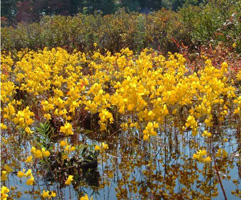Myles Standish State Forest and the Pine
Barrens of Southeastern Massachusetts
PINE BARRENS occur throughout the northeastern U.S. from New Jersey to Maine as well as in the Midwest and Canada. Dry pine forest with oaks (in MSSF they are white, black, and red oak) is the matrix forest of southeastern Massachusetts. It develops on acidic soil formed on sandy glacial deposits: moraine, till, and outwash. The forest structure is rather variable, ranging from open canopy with a dense shrub layer of black huckleberry and scrub oak (together with some dwarf chestnut oak) to close canopy with only scattered clumps of shrubs.
Pitch-pine forest is fire-dependent, supporting more and more white pine and red maple, as the time since the last fire increases. The ground cover is rather sparse, with wintergreen and bracken fern being probably the commonest plants. Pine/oak forest surrounds coastal ponds. On the perimeter of the ponds there is a dense continuous belt of different shrubs, many of them from heath family, with some red maples, gray birches, and sometimes tupelo trees. Pond beaches are an important habitat, supporting many otherwise uncommon plants adapted to drastically changing water levels in ponds. The so-called frost pockets or frost hollows are depressions devoid of tree vegetation, with a continuous shrub and herb layer of sun-loving species, which cope with harsh temperature regime here in order to avoid competition with trees for light. These unique plant communities resemble tundra fragments and harbor such uncommon plants as dwarf upland willow, creeping cherry, wood lily, pasture-thistle, and black oatgrass.
Myles Standish State Forest (MSSF) is the second largest unbroken tract of pitch-pine barrens remaining in the world and is home to a number of rare species of plants and animals. Such rare indigenous plants as New England blazing star, New England boneset, Plymouth gentian, pondshore arrowhead, broom-crowberry, and others occur in the Forest. It is a breeding ground for bluebirds, whippoorwills, and prairie warblers. Redbelly cooters are rare throughout Massachusetts, but they have found refuge in MSSF. Many common and rare moths are dependent on oaks and pines.
Unfortunately, the increased use of motorized recreational vehicles and high recreational pressure has been ruining the habitat of many plants and animals. Fragmentation due to population increase and fire suppression are the biggest ultimate threats to this unique forest. Some believe that pine barrens have developed in response to thousands of years of repeated burning by Native Americans, who started fires to aid hunting. And now, To maintain their characteristic species, pine barrens require a fire interval of less than 50 years.
MSSF is the largest Forest Reserve in Massachusetts. In 2006, the Executive Office of Environmental Affairs designated 11,000 acres of the nearly 15,000 acres in the Myles Standish State Forest as a Large Tract Forest Reserve, thus making MSSF the largest of the nine forest reserves in the Commonwealth and the only such reserve in the state's eastern corridor. Located within the towns of Plymouth, Carver, and Wareham, the MSSF harbors the state's second largest aquifer, which contains an estimated 500 billion gallons of water.
See Forest Reserve Announcement
More Information about Pine Barrens
Southeast Massachusetts preserving pinelands, pond shores and the Taunton River The Nature Conservancy
Pitch Pine Woodlands: A Threatened Natural Community The Nature Conservancy
Myles Standish designated a 'forest reserve'
By Becky W. Evans, South Coast Today, September 22, 2006
Massachusetts Important Bird Areas Site Summary: Myles Standish State Forest Mass Audubon
Integration of Ecology and Forest Management in Forests of Southeastern Massachusetts
Roger Monthey, USDA Forest Service, Durham, NH, and James Rassman, Massachusetts Department of Conservation and Recreation, Carver, MA
Atlantic Coastal Pine Barrens World Wildlife Fund
Nature Conservancy Fire Management Tour
Persius DuskyWing Skipper - Endangered Species of Pine Barrens Mass Wildlife (may be slow to load)


